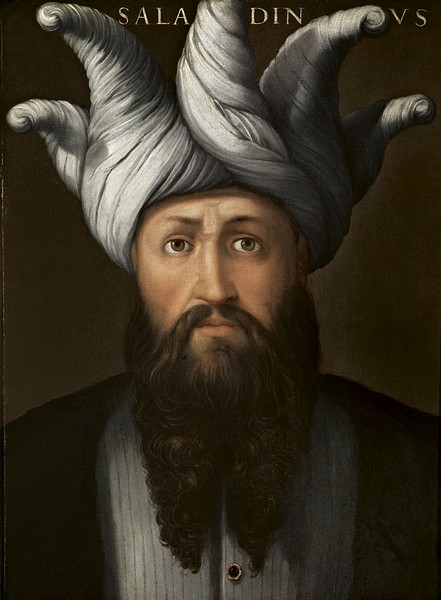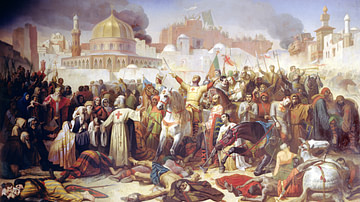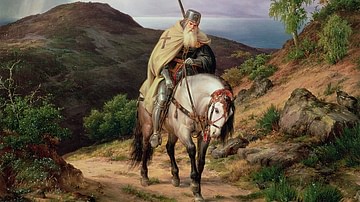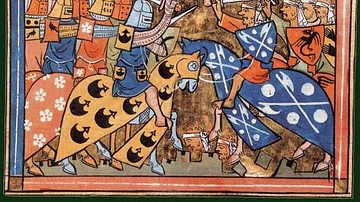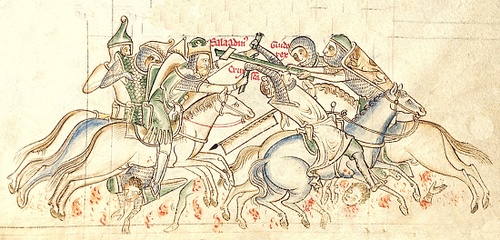
The Battle of Hattin in July 1187 CE in present-day Israel was one of the great victories of Saladin, the Sultan of Egypt and Syria (r. 1174-1193 CE). The army of the Kingdom of Jerusalem and its Latin allies were totally defeated and, shortly after, Jerusalem was captured too. The defeat led to the almost total obliteration of the Crusader States in the Middle East and it would spark off the largely unsuccessful Third Crusade (1189-1192 CE).
Prologue
The Crusader states of the Levant had been created shortly after the First Crusade (1095-1102 CE), and they were the Kingdom of Jerusalem, the County of Edessa, the County of Tripoli, and the Principality of Antioch. The first, with its capital at Jerusalem, was the most important, and although they controlled many fine cities and castles and grew rich from the trade that came through the Levant, the Crusader settlers were forever short of manpower. The Second Crusade (1147-1149 CE) was a dismal failure, and the County of Edessa ceased to exist in 1149 CE, overran by the independent ruler of Mosul (in Iraq) and Aleppo (in Syria), Nur ad-Din (sometimes also given as Nur al-Din, r. 1146-1174 CE). With Crusades spreading to the Iberian peninsula and the Baltic region, the Latin East was in danger of being neglected and forgotten by the western crowns of Europe.
Then a new and most dangerous threat to Christians arrived in the Middle East. Saladin, the founder of the Ayyubid dynasty in Egypt, took control of Damascus in 1174 CE, Aleppo in 1183 CE, and Mayyafariqin in 1185 CE. Mosul bowed to his claim to sovereignty in 1186 CE. The jigsaw of Ayyubid domination was almost complete, all that remained now were the small enclaves of the Crusader states who well knew of the coming storm. Appeals for help to King Philip II of France (r. 1180-1223 CE) and King Henry II of England (r. 1154-1189 CE) fell on deaf ears, despite the offer to gift the kings sovereignty over the Crusader States. Meanwhile, on 1 May 1187 CE, Saladin's army inflicted a serious defeat on a small Latin army at the Springs of Cresson. It was a clear indication that heavily armoured western knights were far from being invincible.
Commanders & Armies
Saladin's army was composed of his own elite bodyguards (the Mamluks, who were mostly of Turkish-Kurdish origin and trained since boys), mercenaries (typically mounted archers), those troops conscripted from Ayyubid lands, and even some volunteers eager for adventure and a religious war. Over several months the army was mustered at a point south of Damascus under the supervision of Saladin's eldest son al-Afdal. At Hattin, Saladin was thus able to field around 12,000 mercenaries and 6,000-12,000 conscripted troops; 12,000 of these men were cavalry. The whole army was organised into three divisions, with Saladin commanding the centre in person.
The Latin army was led by the king of the Kingdom of Jerusalem, Guy of Lusignan (r. 1186-1192 CE) and numbered well over 16,000 men. The Franks (as the Crusader settlers were called by their enemy) had around 15,000 to 18,000 infantry and around 1,300 mounted knights. Almost every able-bodied Frank from the Crusader States had been called up and additional mercenaries bought using the annual money King Henry II of England sent to the Holy Land towards its defence. It was a large army but not as numerous as the enemy and, crucially, the cities and castles of the Crusader States had been stripped of their garrisons in order to assemble it. This was a single throw-of-the-dice gamble; if the Latin field army was lost, so too was the Latin East.
Battle - The Horns of Hattin
On 3 July 1187 CE Saladin attacked the moving Frankish army as it marched from its base at Sapphorie towards Tiberias, which was then under siege from Saladin's army - perhaps in a deliberate attempt to coax the Franks into mobilising. The wife of Raymond of Tripoli was stuck in the besieged citadel of Tiberias, and this may have been the deciding factor in the Franks' mobilisation. Significantly, the Franks would have to travel through the waterless hills of Galilee. Saladin's primary strategy was to have his mounted archers continuously harass the enemy and then quickly retreat. The 12th-century CE historian Imad ad-Din al-Isfahani recorded, "the arrows plunged into them, transforming their lions into hedgehogs" (quoted in Philips, 162). Eventually, the lines of the Latin army became far too stretched out with the Knight Templars at the rear facing the fiercest attacks, but at nightfall, the army managed to make camp. The Muslim army followed suit, but they had the distinct advantage of being able to bring supplies by camel from Lake Tiberias, especially water.
On the morning of 4 July, the Franks attempted to push on to the lake, some 10 kilometres distant. Saladin responded by having his men set fires in the surrounding bush, the heat and smoke thus only adding to the westerners' thirst. When the heat reached its maximum at midday, Saladin's archers, each equipped with 400 arrows, were ordered to let loose a devastating bombardment on the enemy. In the resulting confusion, the Frankish infantry scattered, abandoning their usual protective position around the cavalry. One group, led by Raymond of Tripoli, broke through the encircling Muslims and escaped, although later it would be suggested that they had been permitted to leave by prior agreement, such were the treacherous rivalries, mistrust, and squabbling between the Latin nobles. The general disorder that fateful day was referred to in a contemporary letter sent to the Master of the Knights Hospitaller in Italy. The Franks' discipline had not been as good as it could have been, with many of the western warriors not following in support when the Knights Templars charged the enemy. As a consequence, the Templars found themselves isolated, surrounded and ultimately massacred.
The remaining Franks rallied on the slopes of the twin peaks of Mt. Hattin (really a rather large hill, the remains of an extinct volcano). The peaks were also called the Horns of Hattin, a name which was later frequently applied to the battle itself. The location did offer some meagre protection thanks to a number of ruined Iron Age walls, but now the result was inevitable. Two last and desperate charges directly aimed at Saladin and his bodyguard failed, and the Muslims closed in for victory.
One strategy the Muslim army had used to great effect was to attack the horses of the western knights - whose armour made them almost invulnerable - thus reducing their mobility and permitting their capture. As the 13th-century CE Arab historian Abu Shama states:
A Frankish knight, as long as his horse was in good condition, could not be knocked down. Covered with mail from head to foot, which made him look like a block of iron, the most violent blows make no impression on him. But once his horse was killed, the knight was thrown and taken prisoner. Consequently, though we counted them (Frankish prisoners) by the thousand, there were no horse amongst the spoils whereas the knights were unhurt. (quoted in Nicolle, 45)
Guy of Lusignan was captured but treated hospitably and later released, while Reynard of Chatillon, who had earlier attacked a Muslim caravan in contravention of a truce, got his comeuppance and was mercilessly butchered, the first blow coming from Saladin's own scimitar. Most of the other captured Frankish nobles were set free after the payment of a ransom, but the commoners were sold into slavery. In contrast, according to the Arab historian Ibn al-Athir (d. c. 1233 CE), any captured brothers of the Knights Hospitaller and Knights Templar were executed as Saladin feared their fighting skills and devotion to the Christian cause. The Master of the Templars, Gerard de Ridefort, was spared for ransom, but having lost some 230 of his knights, his order was on its knees.
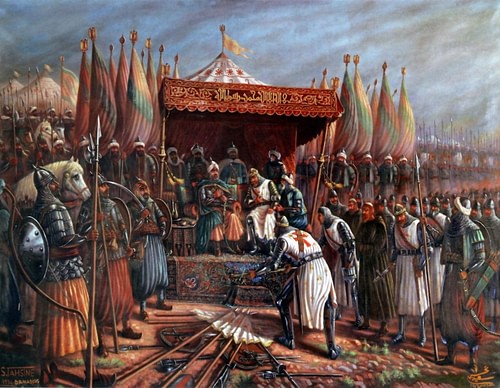
Saladin, besides winning a famous victory got the added bonus of the True Cross holy relic, captured from Guy's royal tent after the battle. The loss of such a precious spiritual talisman was a real blow to the Franks and Western Europe in general. Saladin celebrated the success at Hattin by erecting a domed building at the site, the foundations of which are still visible today.
Aftermath
Saladin followed up his victory by taking control of such cities as Acre, Tiberias, Caesarea, Nazareth, Jaffa and even, the holiest of holies itself, Jerusalem on 2 October 1187 CE. Saladin accepted ransoms from those Latin Christians who could afford to buy their freedom and enslaved the rest (causing a near-crash in the Middle East's slave market). Eastern Christians were permitted to remain in Jerusalem as a protected minority group. The Latin East had all but collapsed, only Tyre remained in Christian hands under the command of Conrad of Montferrat, as well as a handful of castles including Krak des Chevaliers, which would prove very useful for the coming fightback.
The West responded to the loss at Hattin and the immediate fall of Jerusalem by organising the Third Crusade. One of the largest of the crusade campaigns, it would be led by three European monarchs, hence its other name of 'the Kings' Crusade'. The three leaders were: Frederick I Barbarossa, King of Germany and Holy Roman Emperor (r. 1152-1190 CE), Philip II of France, and Richard I 'the Lionhearted' of England (r. 1189-1199 CE). Despite some minor victories and the recapture of Acre, the West could not wrest Jerusalem from Saladin whose Ayyubid dynasty would continue to rule until 1250 CE in Egypt and 1260 CE in Syria.
